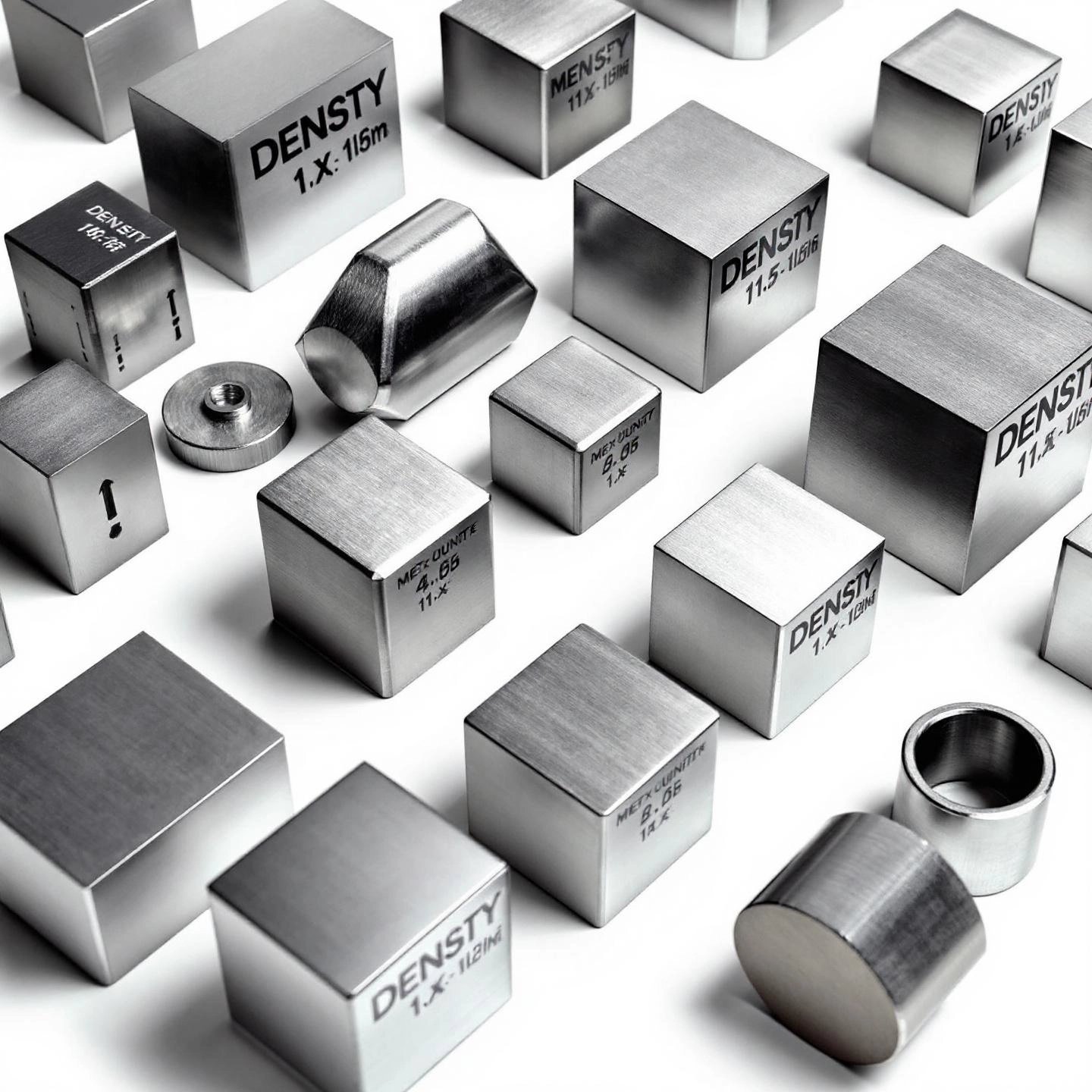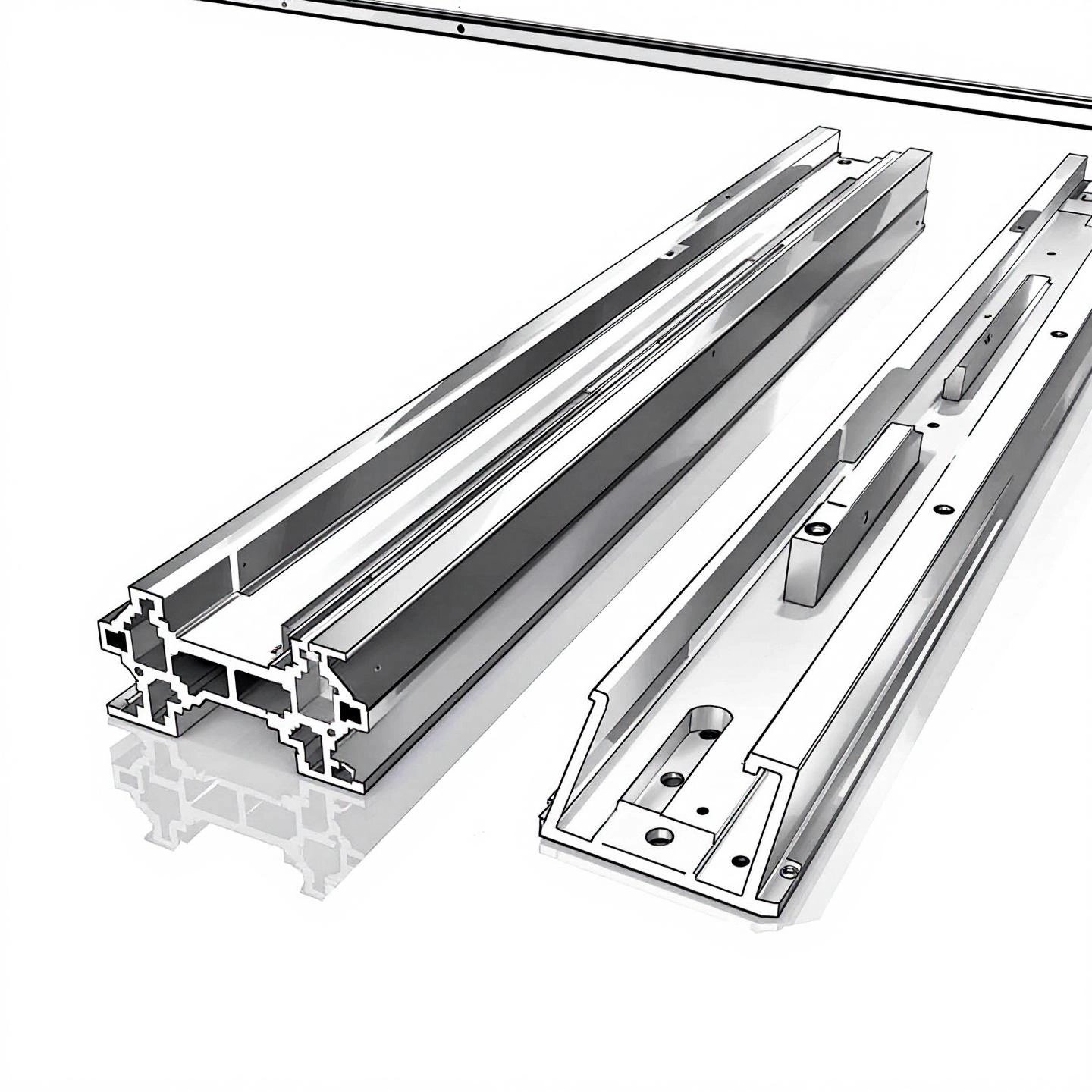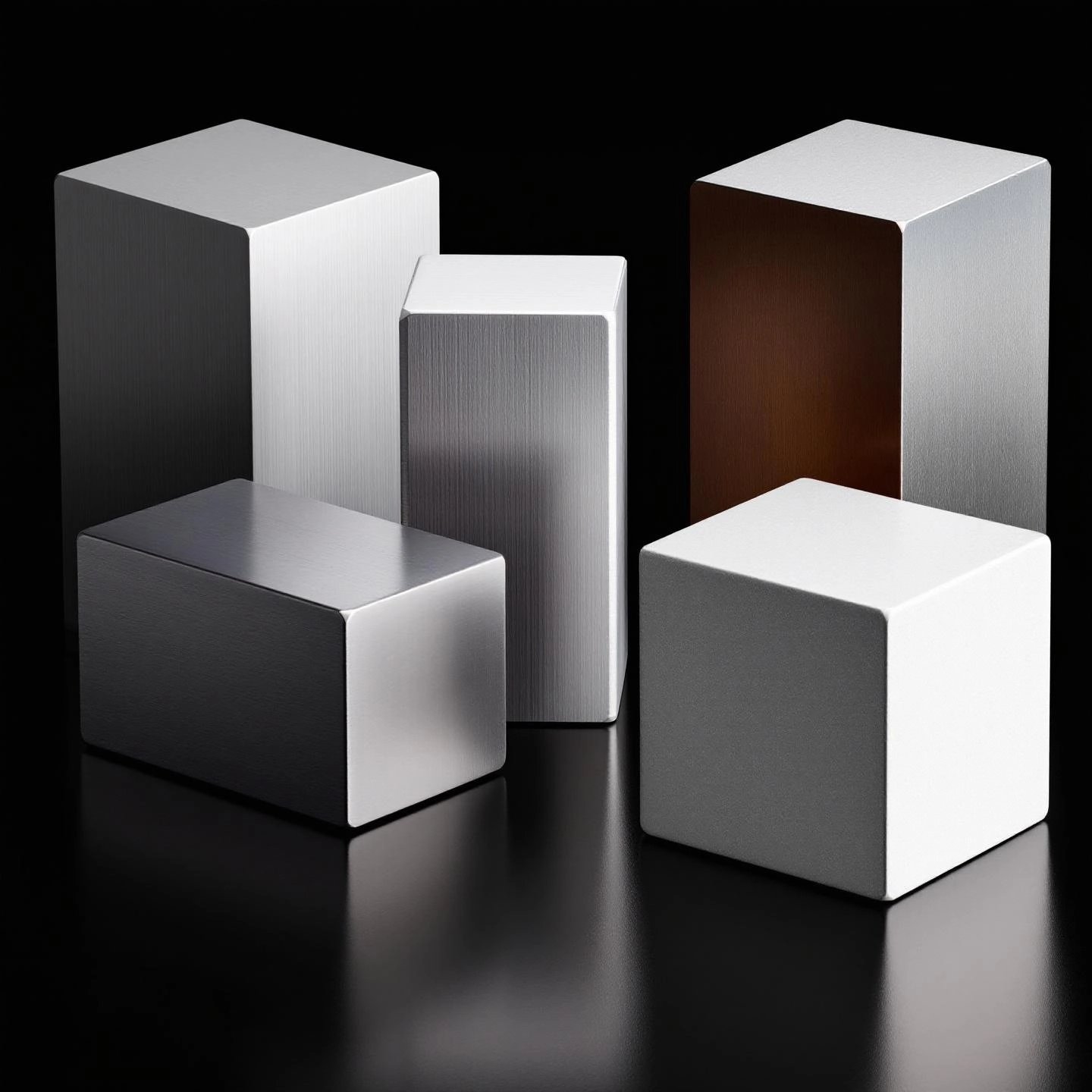
Have you ever picked up a metal part and wondered why some feel surprisingly light, while others seem heavy for their size? The answer often comes down to density—a core property that can make or break the success of your next engineering project. But what exactly is density, and why is the density of aluminum so critical in fields like construction, transportation, and manufacturing?
Let’s start simple: Density is a measure of how much mass is packed into a given volume. The formula is straightforward—just divide the mass (M) by the volume (V):
Density (d) = Mass (M) / Volume (V)
Imagine holding two cubes of equal size—one aluminum, one steel. The aluminum cube feels much lighter. That’s because aluminum’s density is about one-third that of steel, making it a top choice for applications where reducing weight is crucial without sacrificing strength. If you’re still curious about the science, you can explore more in-depth explanations on Encyclopaedia Britannica.
Sounds complex? It doesn’t have to be. Knowing the aluminium density is more than a trivia fact—it’s a practical tool that helps:
Aluminum’s reputation as a lightweight yet strong metal is no accident. Its unique density allows it to deliver impressive durability while keeping products and structures easy to handle, move, and install. In fact, this property is one reason aluminum has become indispensable in industries ranging from electronics to rail transit and energy-efficient buildings. For a comprehensive, real-world perspective, check out this blog post: Aluminum Density: Your Essential Guide to Values & Alloys.
In the sections ahead, we’ll break down everything you need to know about the density of aluminum, including:
Whether you’re an engineer, manufacturer, student, or just a curious reader, mastering the basics of aluminium density will help you make smarter material choices and unlock new possibilities for innovation. Ready to dive in? Let’s start by exploring the standard density values you’ll rely on for every project.
When someone asks, "What’s the density of aluminum?" or "What is the density of aluminum metal?"—the answer is refreshingly straightforward, yet essential for countless real-world applications. The accepted density of aluminum, often used as a reference point in science and engineering, is approximately 2.70 grams per cubic centimeter (g/cm³) or 2,700 kilograms per cubic meter (kg/m³) at room temperature and standard atmospheric pressure.
Let’s break it down: mass density describes how much mass is packed into a specific volume of material. For aluminum, this means that every cubic centimeter (about the size of a sugar cube) weighs just 2.7 grams. If you scaled up to a cube one meter on each side, it would weigh 2,700 kilograms. This consistency is what makes the mass density of aluminum a reliable figure for engineers, manufacturers, and designers alike.
These values are widely accepted in technical standards and are used for everything from calculating shipping weights to designing aircraft frames.
Aluminum’s density is much lower than many other engineering metals—about one-third that of steel. This low density is the secret behind aluminum’s popularity in industries that demand strong materials without the burden of excess weight. Whether you’re building a high-speed train, a lightweight laptop, or an energy-efficient skyscraper, knowing the accepted density of aluminum helps you:
For those interested in the atomic side of things, electron density refers to the number of electrons per unit volume in a material. While this is important in physics and advanced material science, most practical applications focus on mass density—the property that determines how heavy or light a piece of aluminum will feel in your hand.
Now that you know the standard values for pure aluminum, let’s see how these numbers translate into different units and how they compare to the values for common aluminum alloys.

When you’re working on a project—whether it’s designing a lightweight vehicle frame or selecting the right packaging material—how do you quickly determine how much a piece of aluminum will weigh? The answer lies in understanding the density of aluminum using the metric system, which is the global standard for scientific and engineering calculations.
Sounds complicated? It’s actually simple once you know which units to look for. In most technical documents, you’ll see aluminum’s density expressed in one of these three metric units:
For pure aluminum at room temperature, you can rely on these benchmark figures (Shengxin Aluminium):
Let’s put this into perspective: If you have a solid aluminum cube measuring 10 cm on each side (that’s 1,000 cm³ or 1,000 mL), it would weigh about 2,700 grams—or 2.7 kilograms. This simple calculation is why the density of aluminum kg/m3 and density of aluminum g/cm3 are so widely referenced in engineering and manufacturing.
Ever wondered why you sometimes see density listed in g/cm³ and other times in g/mL? Here’s the trick: 1 cubic centimeter (cm³) is exactly equal to 1 milliliter (mL). That means when you see a density value of 2.70 g/cm³, it’s the same as 2.70 g/mL. This equivalence makes it easy to switch between units, especially when converting between solid and liquid measurements.
| Unit | Symbol | Aluminum Density |
|---|---|---|
| Kilograms per cubic meter | kg/m³ | 2,700 |
| Grams per cubic centimeter | g/cm³ | 2.70 |
| Grams per milliliter | g/mL | 2.70 |
These standardized values make it easy to estimate weights, compare materials, and ensure your calculations are both accurate and globally understood. Whether you’re building a bridge or producing aluminum cans, knowing these units will streamline your workflow and prevent costly mistakes.
Next, let’s see how these metric values compare to the imperial units you might encounter in U.S.-based projects or industry standards.
When you’re planning a project in the United States or working with industries that use the imperial system, knowing the density of aluminum in familiar units is a must. But how do you make sense of pounds per cubic inch or pounds per cubic foot? Let’s break it down so you can confidently convert and compare.
Imagine you’re holding a solid aluminum bar or designing a frame for an American-made vehicle. You’ll likely see density listed in:
According to industry references, the typical values for pure aluminum are:
Sounds complex? Not really. The conversion between metric and imperial units relies on fixed factors:
So, if you know aluminum’s density is 2.70 g/cm³, multiplying by 0.03613 gives you roughly 0.098 lb/in³—matching the standard reference value. For pounds per cubic foot, multiplying 2,700 kg/m³ by 0.06243 gets you close to 169 lb/ft³, the commonly cited figure (Aqua-Calc).
You’ll notice imperial units are especially common in:
By understanding both density of aluminum lb/in3 and density of aluminum lb/ft3, you’ll avoid conversion errors and ensure your designs, material orders, and logistics are spot-on—no matter which system your team or client prefers.
Next, let’s take a closer look at how the density of popular aluminum alloys, like 6061 and its T6 temper, compares to these standard values and why those slight differences matter in real-world applications.

When you’re designing a bike frame, a drone chassis, or a structural beam, have you ever wondered: does choosing 6061 aluminum—or its T6 version—change how much your part will weigh? Let’s dig into the density of 6061 aluminum and see why this property is so reliable, no matter the temper or form.
Sounds complex? Here’s the simple answer: the density of 6061 aluminum stays remarkably consistent, whether you’re working with the base alloy or the high-strength T6 temper. Why? Because density is determined by the alloy’s chemical composition and atomic structure—not by heat treatment or mechanical processing.
6061 aluminum is a carefully engineered alloy, primarily composed of aluminum with magnesium and silicon as its main alloying elements. Trace amounts of copper and chromium are also present, but their effect on density is minimal due to their low concentrations (Shengxin Aluminium). The result? Whether you select standard 6061 or 6061-T6, the density remains stable—giving engineers and manufacturers confidence in their weight calculations.
Let’s put the numbers front and center. The density of 6061 aluminum—including 6061-T6—is widely accepted as:
These values are echoed in authoritative engineering databases and industry datasheets (ASM MatWeb). You’ll notice that the density of 6061 T6 aluminum is the same as the base 6061 alloy. The T6 temper, achieved through solution heat treatment and artificial aging, dramatically boosts strength and hardness—but does not meaningfully alter the alloy’s mass-to-volume ratio.
Imagine you’re building an aircraft wing or a custom automotive part. Every gram counts, and you need to trust that your material will perform exactly as calculated. The reliability of 6061’s density means you can:
It’s this predictability that makes 6061 and 6061-T6 aluminum a top choice for everything from aerospace frames to high-performance sporting goods.
While the density of 6061 aluminum is standardized, the real-world performance of your parts depends on manufacturing quality. Sourcing from a reputable supplier—like Shengxin Aluminum—ensures that you receive 6061/6061-T6 profiles produced to tight tolerances and consistent chemical composition. Shengxin’s advanced extrusion, anodizing, and deep processing lines deliver profiles that meet demanding industry standards for rail transit, automotive, and industrial applications.
With over 100 production lines and a proven track record in supplying structural parts for major subway systems and new energy vehicles, Shengxin Aluminum provides the reliability and quality assurance you need for mission-critical projects. Their strict adherence to international standards means you can trust both the density and mechanical properties of every 6061 aluminum profile you specify.
Now that you know why the density of 6061 aluminum is so consistent—and why sourcing quality material matters—let’s see how other popular aluminum alloys compare in density and where these subtle differences can influence your next design choice.
When you’re selecting materials for a project—be it a marine panel, a high-stress aircraft part, or a custom enclosure—you might wonder: does switching from 6061 to another aluminum alloy change the weight of your final product? The answer lies in understanding how alloying elements influence the density of aluminum and why even small differences can matter in engineering and design.
Imagine you’re comparing two aluminum alloys: 5052 and 7075. Both are widely used, but for very different reasons. The density of 5052 aluminum and the density of 7075 aluminum aren’t identical—so what’s behind the difference?
Adding alloying elements like magnesium or zinc slightly increases the density compared to pure aluminum. But these changes are modest—typically within a few percent—yet they can influence both the weight and performance of your finished part.
So, how do these alloys compare in real numbers? Let’s look at the most referenced density values for pure aluminum, 6061, 5052, and 7075, based on trusted industry data:
| Alloy | Primary Alloying Elements | Density (g/cm³) | Density (lb/in³) |
|---|---|---|---|
| Pure Aluminum (1050/1060) | None (99%+ Al) | 2.71 | 0.0977 |
| 6061 | Mg, Si | 2.70 | 0.0975 |
| 5052 | Mg | 2.68 | 0.0968 |
| 7075 | Zn, Cu | 2.81 | 0.102 |
As you can see, 5052 aluminum has a slightly lower density than 6061, thanks to its magnesium content, while 7075 aluminum is noticeably denser due to its higher zinc and copper levels. For example, a 1-liter (1,000 cm³) block of 7075 would weigh about 130 grams more than a similar block of 5052—enough to matter in weight-sensitive applications.
Sounds minor? Consider the impact at scale: in aircraft, every extra kilogram means more fuel consumption; in vehicles, it affects acceleration and efficiency. Choosing a lower-density alloy like 5052 can help keep weight down in marine and transport applications, while the higher-density, high-strength 7075 is justified where maximum structural performance is required.
And remember: even among aluminum alloys, these density shifts are relatively small compared to switching to heavier metals like steel or copper. That’s why aluminum remains the go-to option for balancing strength and weight.
Up next, let’s address a common question—does the form of aluminum, such as foil or sheet, change its density? We’ll clarify why density is an intrinsic material property and what to expect when working with aluminum in different shapes.
Ever wondered if the density of aluminum foil is different from that of a thick aluminum sheet or a solid bar? It’s a common question—after all, foil feels so light and delicate compared to a chunky metal plate. But here’s the key insight: density is an intrinsic property of a material, meaning it doesn’t change based on shape, thickness, or how the metal is processed.
Imagine you’re unrolling a sheet of aluminum foil to wrap leftovers, or comparing it to a sturdy aluminum panel in a construction project. You might expect their densities to differ because they look and feel so distinct. In reality, both forms share the same core property: every cubic centimeter of aluminum—whether foil, sheet, or bar—has nearly the same mass. That’s because density is defined as mass per unit volume, and for aluminum, this value is remarkably consistent.
According to industry sources, the density of aluminum foil is essentially the same as that of pure aluminum or aluminum sheet—about 2.7 g/cm³. The difference in how heavy or light a piece feels comes from its thickness, not its density. So, a thin foil is light because there’s less material overall, not because the density is lower.
It’s true that aluminum foil is often made from slightly different alloys or processed for flexibility, but these changes have only a minor effect on density. Any variation is typically negligible—well within a few percent of the standard value. For most practical purposes, you can confidently use aluminium density g/cm3 values when calculating mass, packaging needs, or thermal properties for foil products.
In summary, when you reach for aluminum foil or specify aluminum for a project, you can count on its density staying the same—no matter how thin or thick it is. This consistency makes aluminum a predictable, reliable choice for everything from kitchen wraps to advanced engineering solutions.
Next, let’s see how aluminum’s density compares to other engineering materials like steel, and why this matters for weight-sensitive applications.

When you’re choosing the right material for your next project, have you ever wondered: “How much lighter would my design be if I switched from steel to aluminum?” Or, “Why do automakers and aircraft manufacturers favor aluminum for so many parts?” The answer lies in a direct comparison of the density of steel vs aluminum—and the practical benefits that follow.
Let’s break it down with real numbers. Aluminum’s density is about 2.7 g/cm³ (or 0.0975 lb/in³), making it one of the lightest commonly used engineering metals. In contrast, steel—depending on the alloy—typically weighs in at 7.85 g/cm³ (or 0.284 lb/in³). That means steel is nearly three times heavier than aluminum for the same volume.
But what about other popular materials? Here’s a quick reference table for easy comparison:
| Material | Density (g/cm³) | Density (lb/in³) |
|---|---|---|
| Aluminum | 2.7 | 0.0975 |
| Steel (carbon) | 7.85 | 0.284 |
| Titanium | 4.5 | 0.163 |
| Copper | 8.96 | 0.324 |
| Magnesium | 1.74 | 0.063 |
It’s not just about being lightweight. Aluminum also brings a suite of other aluminium properties to the table:
Imagine building a subway car or a next-generation electric vehicle. If you use steel, the structure becomes heavier, requiring more powerful (and expensive) motors and increasing energy consumption. With aluminum, you achieve the same structural performance with far less weight. This is why advanced manufacturers, like Shengxin Aluminum, are trusted to supply high-precision aluminum profiles for rail transit, automotive, and aerospace projects where every gram counts.
Aluminum’s low density isn’t just a number—it’s a catalyst for innovation. From lightweight laptops to skyscraper curtain walls, aluminum enables products and structures that are easier to move, more energy-efficient, and often more sustainable. Its combination of lightness, strength, and versatility continues to drive advancements in manufacturing, design, and green technology.
As you weigh your material options for your next project, remember: understanding the density of aluminum compared to steel and other metals is the first step toward smarter, more efficient engineering. In the next section, we’ll explore the factors that can cause slight variations in aluminum’s density and why consistent quality matters for your application.
Ever wondered why the density of aluminum alloy can sometimes differ slightly from the textbook value? Or why two seemingly identical aluminum parts might not weigh exactly the same? The answer lies in a handful of scientific and real-world factors that influence aluminum’s precise density. Let’s break them down so you can confidently predict, calculate, and control the density of aluminum in your own projects.
Sounds complex? It’s actually a handful of key factors—most of which you can spot or control if you know what to look for:
Imagine you’re manufacturing aerospace components or precision parts for electronics. Why does consistency matter? Because even minor density variations can impact weight, strength, and overall performance. Here’s how you can ensure reliable results:
Density (ρ) = Mass / VolumeMeasure mass with a precise scale and volume by geometric calculation or water displacement for irregular shapes. This practical approach ensures your calculations match real-world results.
In summary, while the density of aluminum and its alloys is remarkably consistent, small variations can arise from alloy composition, temperature, purity, manufacturing technique, and microstructure. By understanding and controlling these factors, you’ll ensure your aluminum parts meet exacting standards—whether you’re building bridges, aircraft, or cutting-edge electronics. In the final section, we’ll wrap up with key takeaways and practical advice for choosing the right aluminum for your needs.

When you step back and look at the big picture, the density of aluminum is more than just a number—it’s a defining property that shapes how we build, move, and innovate. Throughout this guide, we’ve explored the standard density values for pure and alloyed aluminum, examined how alloying elements and processing can cause slight variations, and seen why low density is a game-changer across industries.
Imagine you’re designing a next-generation electric vehicle, planning a high-rise façade, or developing eco-friendly packaging. In each scenario, considering aluminum’s density helps you:
But here’s a critical point: the benefits of aluminum only reach their full potential when you choose high-quality material from a trusted aluminum profile manufacturer. Consistent density and precise alloying ensure your parts meet performance, safety, and regulatory standards—project after project.
If you’re seeking tailored solutions or want to ensure the highest quality for your next project, consider partnering with a proven industry leader. Shengxin Aluminum combines cutting-edge manufacturing, deep expertise, and a commitment to quality—making them a top choice for demanding applications in rail transit, automotive, construction, and beyond.
Curious to learn more about how aluminum’s density can unlock new possibilities for your business or design? Dive deeper into our resources or reach out to Shengxin Aluminum for expert guidance and custom solutions. The right material choice starts with understanding—and now, you have the knowledge to make it count.
Aluminum has a density of about 2.70 g/cm³ (2,700 kg/m³), making it much lighter than metals like steel. This low density is key to its widespread use in industries that require strong yet lightweight materials, such as automotive, aerospace, and construction.
The density of aluminum is approximately 169 lb/ft³. This value is commonly used in U.S. engineering and construction projects for calculating material weights and optimizing structural designs.
While the density of pure aluminum is about 2.70 g/cm³, alloying elements like magnesium or zinc can cause slight variations. For example, 5052 alloy is slightly less dense, while 7075 alloy is a bit denser due to its zinc and copper content. However, these differences are typically small and predictable.
No, the density of aluminum foil is the same as that of bulk aluminum. Density is an intrinsic property, so regardless of whether aluminum is in foil, sheet, or bar form, its density remains consistent unless alloyed with other elements.
Knowing aluminum's density helps engineers and manufacturers design lighter, more efficient products. It affects calculations for weight, load-bearing, shipping, and energy efficiency, making it essential for selecting the right material for applications in transportation, construction, and high-tech industries.
 Onlineservice
Onlineservice 0086 136 3563 2360
0086 136 3563 2360 sales@sxalu.com
sales@sxalu.com +86 136 3563 2360
+86 136 3563 2360